In case you’ve been thinking of getting a personal air purifier for your own home/space, this post will help.
Under the lifestyle pillar is where you’ll find all these other miscellaneous things that add up quickly on your healing journey.
And if you remember, I’ve said it a million times, but it’s the lifestyle pillar that is the hardest to get right.
It’s not always your fault, though.
We can’t live in a bubble and therefore as the world spins around us so do the factors that make (or keep) us sick.
Personal Air Purifier
Click HERE to save this post for later.

I’ve been searching for a top-quality air purifier (and water filter) for quite some time.
I have found both, but this post is solely about the air purifier. (Spoiler alert: we have the AquaTru water filtration system.)
Now, you might think that I wanted this air purifier strictly for my personal benefit. And had I not fully healed my gut, it might be the case.
But that’s not why I was desperate for an air purifier now. (The lifestyle pillar of my gut healing beliefs just happens to be a huge benefit.)
The reason I was so desperate is because of my daughter, Samarah. She’s 8. Her allergies are horrendous, and we have 3 dogs that she does not want to get rid of.
As sort of a last resort, we finally said, “Okay, let’s see if an air purifier can help.”
So before I talk about our new air purifier, I want to give supportive information.
Air Molecules
Understanding air molecules will help you understand why an air purifier can be so beneficial for those with any sort of breathing issue, and also those on a gut healing journey (you’ll see – it will make sense).
Air mostly consists of gasses such as carbon dioxide, hydrogen, nitrogen, oxygen, water vapor and some other gases. Additionally, gases contain smoke, dust, acid droplets, and pollen.
Air is invisible to our naked eye, and it is constantly causing some effects in our environment.
Atmosphere’s composition changes constantly depending on the season, weather, time, elevation, and geography of any given place.
Some air molecules that affect air quality are created naturally; others are the result of human activity. (source)
Did you know? The composition of air outside sometimes interrupts some plans due to its index. The Air Quality Index, or AQI, is used to assess air pollution. The lower the AQI, the better the air quality.
However, if you are outside while the AQI is over 100, it is almost equivalent to breathing in automobile pollution all day! Forest fires and cities with heavy traffic both contribute to poor air quality. (source)
Besides that, though, here are some air particles that cause allergies.
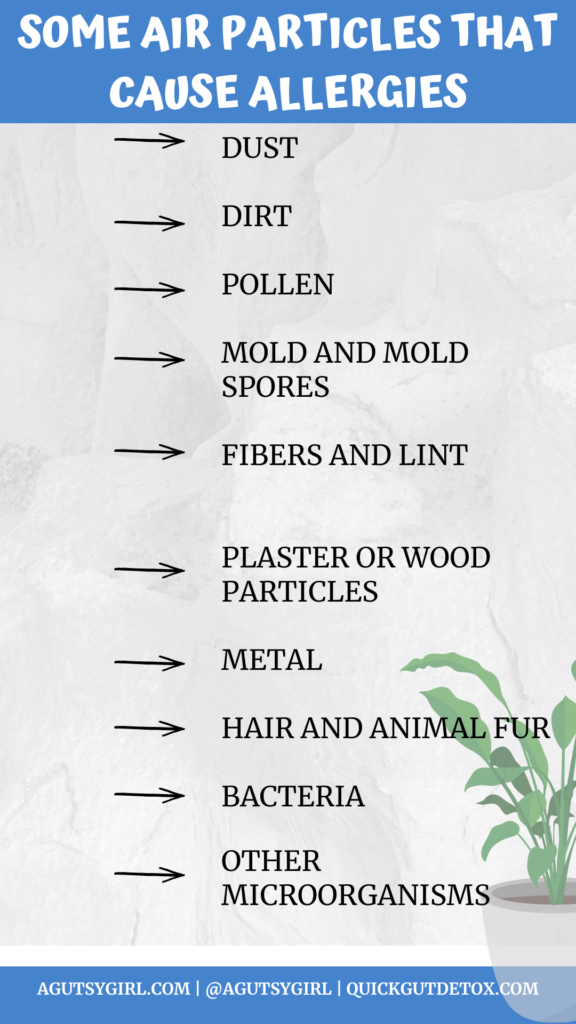
Some air particles that cause allergies:
- Dust
- Dirt
- Pollen
- Mold and mold spores
- Fibers and lint
- Metal
- Plaster or wood particles
- Hair and animal fur
- Bacteria
- Other microorganisms
These air particles can cause allergic reactions, cough, a runny nose, sneezing, nausea, or headaches.
Due to this, these substances can cause long-term problem in respiratory system and even other body systems.
Particles and gas can affect the quality of air, indoor or outdoor.
Indoor Air Quality
Dust, pet hair, pests, and viruses commonly affect the indoor air quality. (source)
And, here are more sources of indoor air pollution, as stated directly from the Environmental Protection Agency:
- Fuel-burning combustion appliances
- Tobacco products
- Building materials and furnishings as diverse as:
- Deteriorated asbestos-containing insulation
- Newly installed flooring, upholstery or carpet
- Cabinetry or furniture made of certain pressed wood products
- Products for household cleaning and maintenance, personal care, or hobbies
- Central heating and cooling systems and humidification devices
- Excess moisture
- Outdoor sources such as:
- Radon
- Pesticides
- Outdoor air pollution.
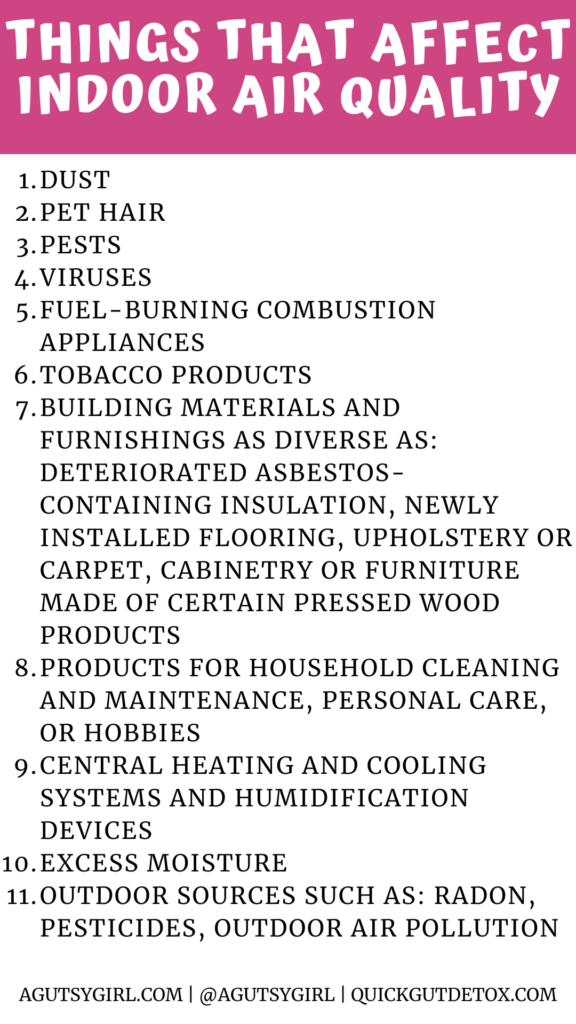
Allergies and asthma can be intensified by indoor and outdoor pollution and allergens.
And BINGO! All of the above is why I decided we needed an air purifier in our house.
Air purifiers can, in fact, mitigate some of the risks presented by air pollution and indoor activities. Air purifiers often have a filter, or many filters, as well as a fan that draws in and circulates air.
Pollutants and particles are collected when air passes through the filter, and clean air is pumped back into the living room. Filters are often constructed of paper, fiber (commonly fiberglass), or mesh, and must be replaced on a regular basis to maintain performance. (source)
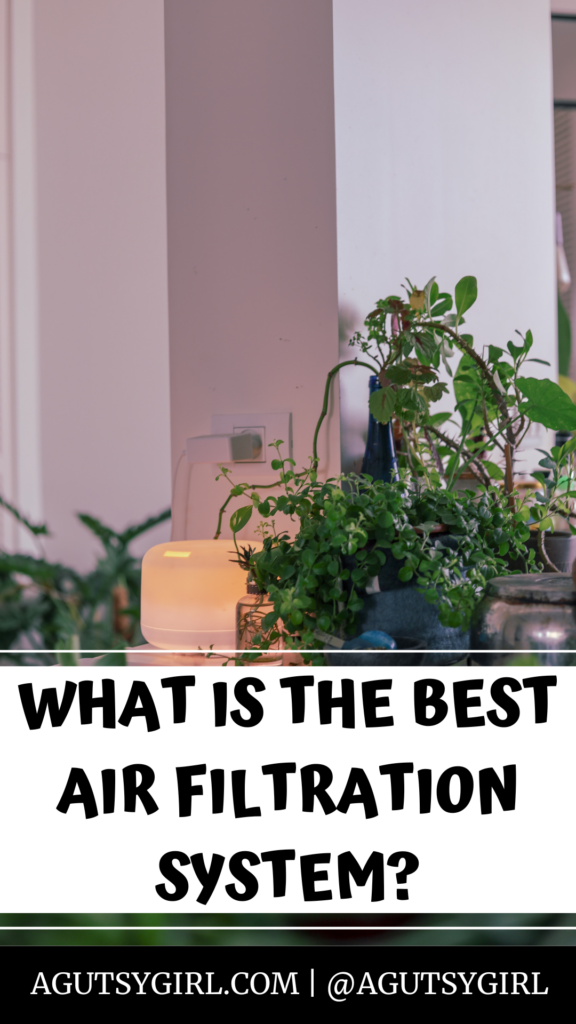
Types of Air Purifiers
Okay, so now that we have gone over the air and why an air purifier might be on your radar, let’s get into more of the nitty gritty.
While we can’t get rid of every particle indoors, there are ways to mitigate the exposures.
One of these is to have an air purifier.
But how do you know which air purifier to choose?
Here are 7 types of air purifiers.
p.s. Keep in mind that these are not all types. This is not meant to be a comprehensive list, but instead a list to help you understand a little more about common filters.
UV (Ultraviolet) Light Filters
These are built-in components, commonly sold as add-ons to a whole-house electronic precipitator. Its ultraviolet light kills airborne bacteria and viruses, the main reason why it is use by some hospitals in tuberculosis wards.
Ionic Air Purifier
Usually used in conjunction with one or more other types of filtration, ionizers are devices that electrically charge molecules in the air to form ions.
Normal particles floating in the air have a neutral charge, so when they come in contact with the ions or the ozone they end up with a charge, too. That causes them to stick to surfaces around the room instead of floating through the air.
HEPA Filters
HEPA stands for High Efficiency Particulate Arrestance.
They provide the highest protection for your home, and are able to remove even the smallest microns or airborne particles, including tobacco and bacteria.
The HEPA filters are required by law to filter at least 99.97% of particles greater than 3 microns in diameter.
Those who live with allergies or other respiratory issues may benefit from HEPA filters the most.
Spoiler Alert: This is what the AirDoctor uses.
Carbon Air Filters
Carbon filters trap odors through a process called adsorption, which occurs when molecules attach to the outside of a surface, rather than being soaked into it (that’s absorption).
The more porous the activated carbon, the better, as this will increase the amount of surface space available for contaminants to latch onto when air passes through the filter. (source)
Electrostatic Filters
They are also known as electrostatic precipitators. As air passes through it, high-voltage current puts an electric charge on particles.
It works efficiently on smoke particles which are too little to be trapped using media filters. It does not need replacing, but its aluminum collector plates must be cleaned in soapy water every few months.
Flat Filters
They are designed to protect from large particles of dust and keep surfaces in the house a bit cleaner. However, flat filters won’t block the microscopic particles that may cause irritation to the lung tissue.
Dust Filter
A dust filter is a device modeled to trap or remove some particles from the air.
Dust filters can improve the air quality humans breathe by collecting dust and other impurities from air or gas.
A dust filter is not just an ordinary filter. It can do a lot of things such as controlling particles but also fumes, vapors, and other pollutants. Some chemicals can also be eliminated just by dust filters.
Keeping a house clean and adequately ventilated is the first line of protection against airborne pollutants. However, for certain sensitive persons, this may not be sufficient. This is where air filters come into play.
Two Types of Dust Filters:
- Automatic/Manual or Portable Dust Filter
Portable Dust Filter designed to give versality, for having small and being able to maneuver.
2. Stationary Dust Filter
Requires installation and daily maintenance by professional personnel, they are often custom made or sized-to-fit.
Filter sources: HERE, HERE, HERE, HERE, and HERE.

AirDoctor: The Air Purifier I Chose
After it was all said and done, I chose the AirDoctor.
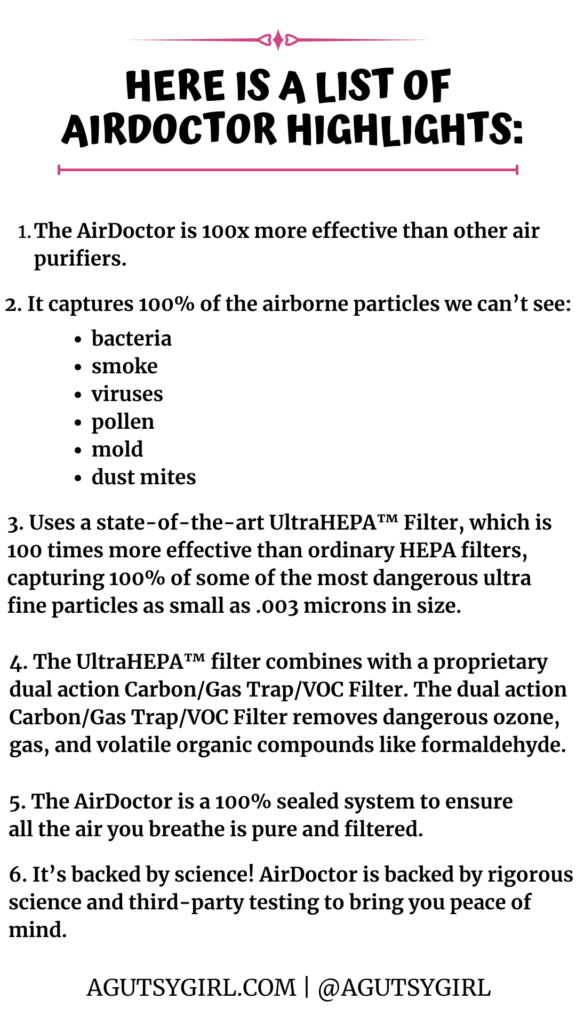
Here is a list of AirDoctor highlights:
- The AirDoctor is 100x more effective than other air purifiers.
- It captures 100% of the airborne particles we can’t see:
- bacteria
- smoke
- viruses
- pollen
- mold
- dust mites
- Uses a state-of-the-art UltraHEPA™ Filter, which is 100 times more effective than ordinary HEPA filters, capturing 100% of some of the most dangerous ultra fine particles as small as .003 microns in size.
- The UltraHEPA™ filter combines with a proprietary dual action Carbon/Gas Trap/VOC Filter. The dual action Carbon/Gas Trap/VOC Filter removes dangerous ozone, gas and volatile organic compounds like formaldehyde.
- The AirDoctor is a 100% sealed system to ensure all the air you breathe is pure and filtered.
- It’s backed by science! AirDoctor is backed by rigorous science and third-party testing to bring you peace of mind.
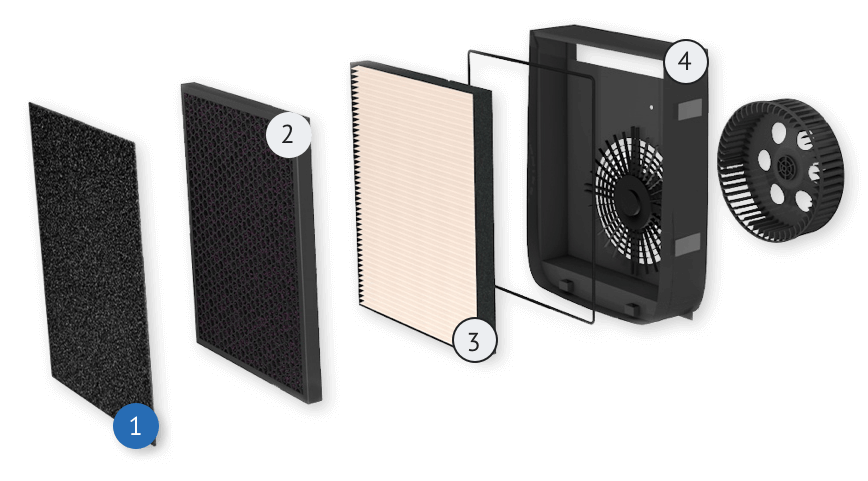

Here are some other things I like about the AirDoctor:
- An indicator light automatically comes on when it’s time to replace the filters.
- Money back guarantee.
- The AirDoctor 3000, which is the one we have, is powerful enough to fit in any room of your home, including family rooms, kitchens, bedrooms, and any other space that needs clean air, AirDoctor 3000 circulates the air in a 505 sq. ft. room 5x/hour or in a 1262 sq. ft room 2x/hour.
- The first set of filters come with your purchase, so you can start using it immediately upon arrival.
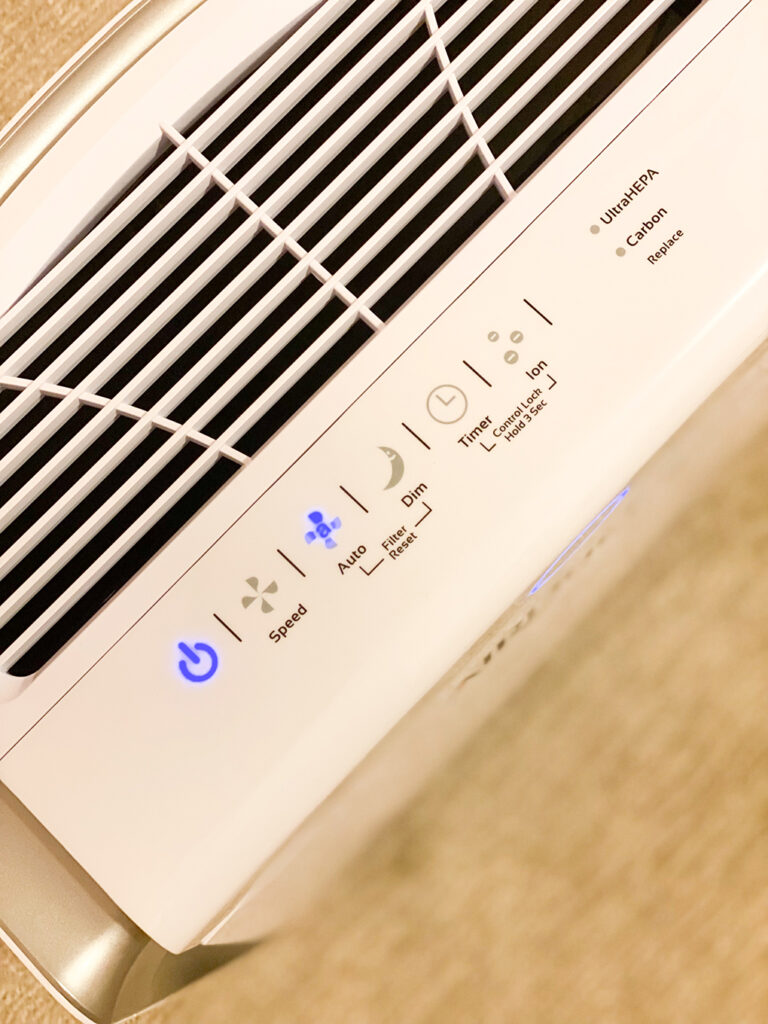
Quiet Air Purifier
Some air purifiers are super loud. I can’t handle that when I’m sleeping, and I definitely didn’t want it waking my kids up.
The AirDoctor uses an exclusive Professional WhisperJet fans that is 30% quieter than the fans found in ordinary air purifiers.
Since having the air purifier, I can confirm that it’s super quiet on the first two levels. Our air quality is not always great in here, so when it reaches the “red” zone, I don’t think it’s super quiet. But being in that zone is super short-lived, even for us.
AirDoctor 3000
As I mentioned above, we have the AirDoctor 3000.
Upon arrival, it immediately went in my daughter’s room.
Here she is, looking so lovely.
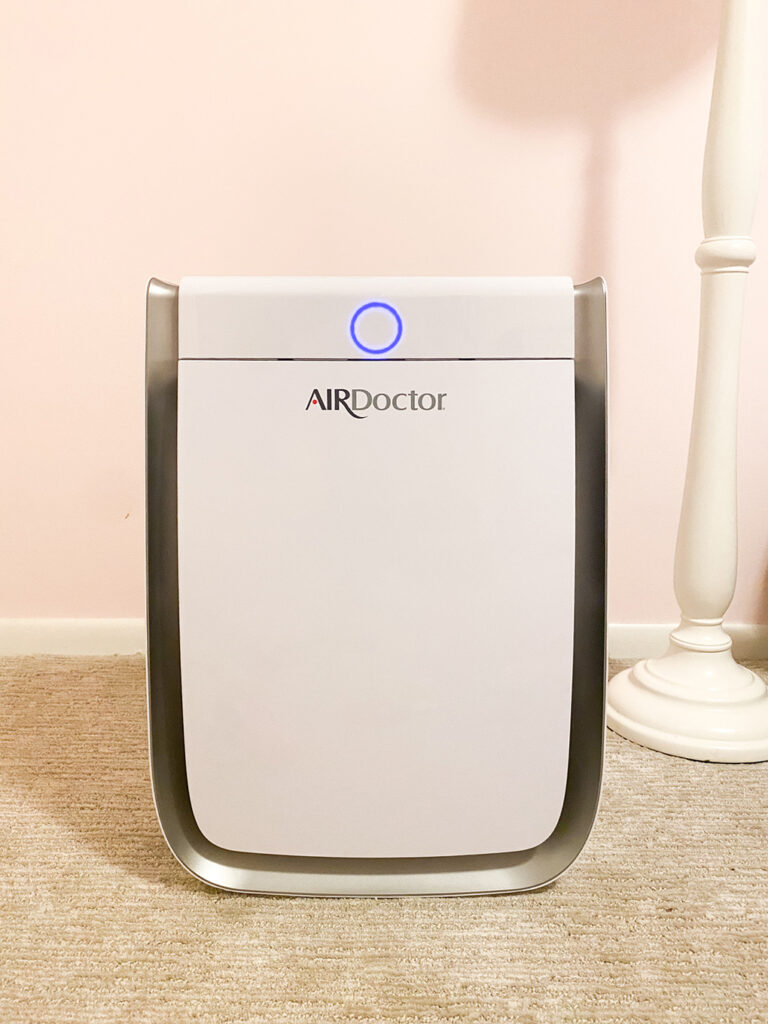
When I got the Virus a couple days later, I then moved it to our room, for good measures.
In both rooms, the purifier has hit all three zones:
- Blue – good air quality
- Yellow – moderate air quality
- Red – poor air quality
But I am happy to report that Samarah is sleeping much better in her room when it’s on and in there.
In fact, I’m planning on getting a few more, over time – they aren’t cheap, because I truly think they help.
Happy to answer any questions you might have. Just leave them in the comments below.
If you liked this post, you might also enjoy:
Affiliate disclosure: The AirDoctor products and links in this post are affiliates. When you purchase anything from AirDoctor, you will save a hefty amount and I make a small commission. This is part of my business that helps keep this website afloat for me to bring you the information for free. And I’m so grateful for you.
Xox,
SKH
🤰 bloating be gone! weight loss through optimal gut health for women
💃ʜᴇᴀʟ ʏᴏᴜʀ ɢᴜᴛ. ʜᴇᴀʟ ʏᴏᴜʀ ʟɪfe.
🫶🏻 founder gutbyome.com






